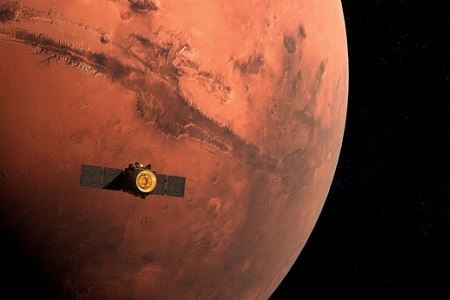
The United Arab Emirates’ first Mars mission, Hope, has entered orbit around the planet on February 9. The UAE made history, as the first Arab nation, and the fifth in the world to reach Mars.
Hope completed a 27-minute burn of its main thrusters, slowing the spacecraft down enough to enter an initial “capture” orbit around Mars, at 10:57 a.m. EST, the Mohammed Bin Rashid Space Centre announced. Signals from the spacecraft confirming a successful orbital insertion arrived 11 minutes later.
The probe overcame the most critical part of its mission, the Mars Orbital Insertion (MOI) that involved reversing and firing its six Delta V thrusters to rapidly reduce its speed from 121,000 km/h to 18,000 km/h. During the 27-minute critical phase, the contact kept with the probe was kept to a minimum.
The Hope Probe is the first of three exploration missions to arrive to the Red Planet in February. China and the US are leading ambitious projects to Mars, scheduled to arrive on February 10 and February 18 respectively. Hope Probe’s arrival to Mars, after travelling 493m kilometres in a seven-month journey in space, marks the UAE’s 50th anniversary celebrations.
The probe, along with its three scientific instruments, is expected to create the first complete portrait of the Martian atmosphere. The instruments will collect different data points on the atmosphere to also gauge seasonal and daily changes.
Omran Sharaf, Project Manager of the Emirates Mars Mission, announced: “To the people of UAE and to the peoples of Islamic and Arab nations, we announce the success of the United Arab Emirates in (reaching) the orbit of the Red Planet. We thank God.”
The craft swung into a high Martian orbit, joining six spacecraft already operating around the planet — three US, two European and one Indian. Mission controllers had to pull off a series of delicate turns and power adjustments to manoeuvre the probe into position.
Sarah Al-Amiri, minister of state for advanced technology and the chair of the UAE’s space agency described the mission’s success as “a historic development and a fulfilment for the dreams of 200 engineers and scientists” who worked behind the scenes.
Hailing the success of the mission, Mohammed bin Rashid Al Maktoum, Vice President and Prime Minister of the UAE and Ruler of Dubai, said: “The Hope probe’s historic arrival to Mars is the greatest celebration of the 50th anniversary of our country. It sets the beginning of the next 50 years with boundless ambitions and dreams.
“Our next accomplishments will be even bigger and greater. Our biggest success is building national scientific expertise who will contribute to the international science community.
“We dedicate our Mars achievement to the people of the UAE and the rest of the Arab world. Our success proves that Arabs are capable of reviving the region’s legacy and status in the scientific sphere. We mark our country’s 50th anniversary by our Mars stop, and invite Arab youth to join the UAE’s science movement that marched at high speed.”
Hope will complete one scientific orbit of the planet every 55 hours. This orbit will provide the first global picture of weather and atmospheric dynamics on Mars, which will be shared with the scientific community via the mission’s data centre.
The mission is expected to last two years, with the possibility of being extended for a third year. The probe will be in a different orbit from past spacecraft that have visited Mars.












Add Comment